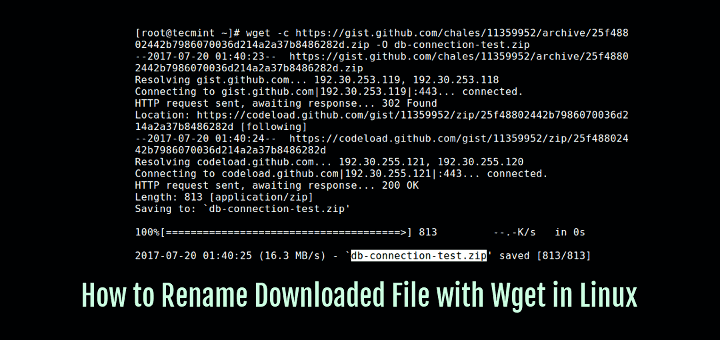

Download list of files with wget - sorry
Downloading files with wget
Shared
VPS
Dedicated
WP Professional
WP Professional Plus
The wget command is an internet file downloader that can download anything from files and web pages all the way through to entire websites.
Basic Usage
The wget command is in the format of:
wget [options] urlFor example, in its most basic form, you would write a command something like this:
wget http://www.domain.com/filename.zipThis will download the filename.zip file from www.domain.com and place it in your current directory.
Redirecting Output
The option sets the output file name. If the file was called filename-4.0.1.zip and you wanted to save it directly to filename.zip you would use a command like this:
wget -O filename.zip http://www.domain.com/filename-4.0.1.zipThe wget program can operate on many different protocols with the most common being ftp:// and http://.
Downloading in the background.
If you want to download a large file and close your connection to the server you can use the command:
wget -b urlDownloading Multiple Files
If you want to download multiple files you can create a text file with the list of target files. Each filename should be on its own line. You would then run the command:
wget -i filename.txtYou can also do this with an HTML file. If you have an HTML file on your server and you want to download all the links within that page you need add to your command.
To use this, all the links in the file must be full links, if they are relative links you will need to add following to the HTML file before running the command:
wget --force-html -i filename.htmlLimiting the download speed
Usually, you want your downloads to be as fast as possible. However, if you want to continue working while downloading, you want the speed to be throttled.
To do this use the option. You would use it like this:
Continuing a failed download
If you are downloading a large file and it fails part way through, you can continue the download in most cases by using the option.
For example:
wget -c http://www.domain.com/filename.tar.gzNormally when you restart a download of the same filename, it will append a number starting with .1 to the downloaded file and start from the beginning again.
Downloading in the background
If you want to download in the background use the option. An example of this is:
wget -b http://domain.com/filename.tar.gzChecking if remote files exist before a scheduled download
If you want to schedule a large download ahead of time, it is worth checking that the remote files exist. The option to run a check on files is .
In circumstances such as this, you will usually have a file with the list of files to download inside. An example of how this command will look when checking for a list of files is:
wget --spider -i filename.txtHowever, if it is just a single file you want to check, then you can use this formula:
wget --spider http://www.domain.com/filename.tar.gzCopy an entire website
If you want to copy an entire website you will need to use the option. As this can be a complicated task there are other options you may need to use such as , , , and .
| -p | This option is necessary if you want all additional files necessary to view the page such as CSS files and images |
| -P | This option sets the download directory. Example: |
| --convert-links | This option will fix any links in the downloaded files. For example, it will change any links that refer to other files that were downloaded to local ones. |
| --reject | This option prevents certain file types from downloading. If for instance, you wanted all files except flash video files (flv) you would use |
| --user-agent | This option is for when a site has protection in place to prevent scraping. You would use this to set your user agent to make it look like you were a normal web browser and not wget. |
Using all these options to download a website would look like this:
wget --mirror -p --convert-links -P ./local-dir --user-agent="Mozilla/5.0 (Windows NT 6.3; WOW64; rv:40.0" http://www.domain.com/TIP: Being Nice
It is always best to ask permission before downloading a site belonging to someone else and even if you have permission it is always good to play nice with their server. These two additional options will ensure you don’t harm their server while downloading.
--wait=15 --limit-rate=50KThis will wait 15 seconds between each page and limit the download speed to 50K/sec.
Downloading using FTP
If you want to download a file via FTP and a username and password is required, then you will need to use the and options.
An example of this might look like:
wget --ftp-user=USERNAME --ftp-password=PASSWORD ftp://ftp.domain.com/filename.tar.gzRetry
If you are getting failures during a download, you can use the option to set the number of retries. Such a command may look like this:
wget -t 50 http://www.domain.com/filename.tar.gzYou could also set it to infinite retries using .
Recursive down to level X
If you want to get only the first level of a website, then you would use the option combined with the option.
For example, if you wanted only the first level of website you would use:
wget -r -l1 http://www.example.com/Setting the username and password for authentication
If you need to authenticate an HTTP request you use the command:
wget --http-user=USERNAME --http-password=PASSWORD http://domain.com/filename.htmlwget is a very complicated and complete downloading utility. It has many more options and multiple combinations to achieve a specific task. For more details, you can use the command in your terminal/command prompt to bring up the wget manual. You can also find the wget manual here in webpage format.

-
-
-